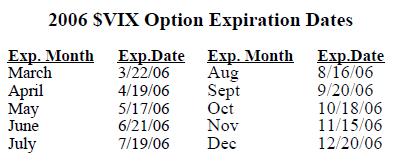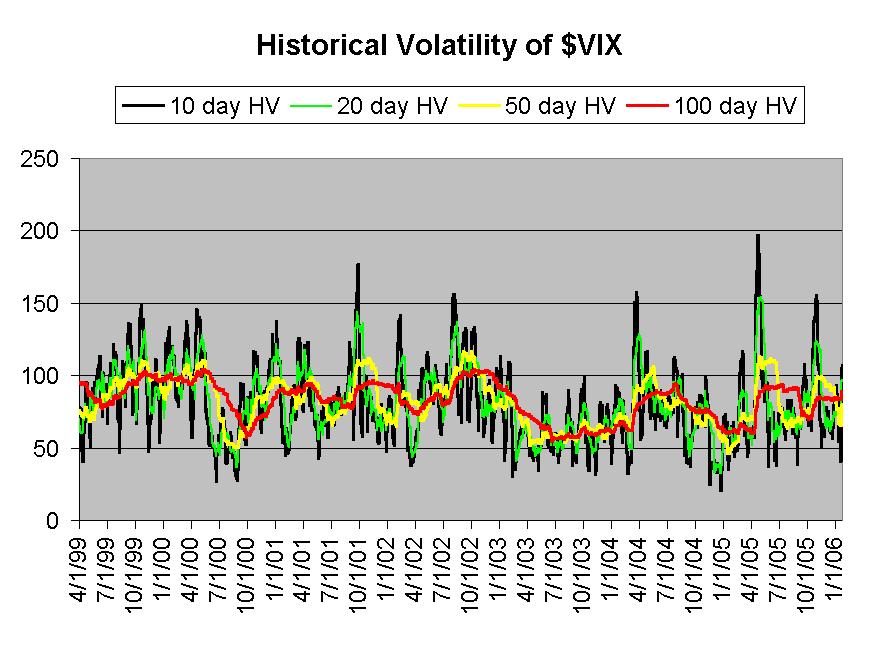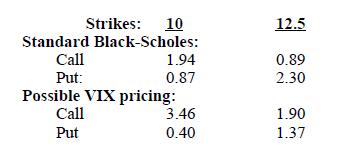
By Lawrence G. McMillan
This article was originally published in The Option Strategist Newsletter Volume 15, No. 2 on January 26, 2006.
After a lengthy delay, the CBOE has announced that $VIX futures will begin trading on Friday, February 24th. We first wrote about these options last March (2005) when it seemed imminent that they would begin trading. However, there was a delay – a delay which is about over. In this article, we’ll lay out the specifications of the contracts once again, and refresh your memories on a few important points about how the contracts might trade.
First and foremost, it should be understood that these are options on the cash $VIX, much as there are options on $SPX or $OEX. These are not options on any of the Volatility or Variance futures. As a cashbased index option, they can be traded in a regular stock option account, with your favorite brokerage firm, just as index options can.
There will initially be just three expiration months – the two front months, plus the next month on the February cycle (Feb, May, Aug, Nov). So, on February 24th, there will be options expiring in March, April – the two front months – and May (the next month on the February cycle). The distance between striking prices will be a minimum of 2-1/2 points. Let’s hope they soon reduce the interval to one point apart. 2-1/2 points is an awfully long way for something as relatively stable as $VIX has been in the last few years.
Note: in the original $VIX proposal – last year – the underlying index was going to be $VXB, which is $VIX times 100. That is no longer the case, which should help to simplify things for all traders.
There is one important difference between these options and normal stock and index options: they will expire on the Wednesday that is 30 days before the 3rd Friday of the calendar month immediately following the expiration month. What? The reason for this is somewhat arcane, but suffice it to say that it has to do with giving the market maker an easier way to hedge his positions as a more or less “pure” arbitrage. Simply stated these options will expire on the Wednesday just before regular options expire or the Wednesday just after. Here are some examples:
March $VIX options: will expire based on when regular April stock and index options expire. The third Friday of April is April 21st this year. 30 days prior to that is Wednesday, March 22nd – and hence is the expiration date of the March $VIX options. This falls after the regular March expiration date for stock and index options (March 17th) because there are five weeks between the 3rd Friday of March and the 3rd Friday of April this year.
Let’s look at another: April $VIX options will expire based on when “regular” May options expire. The 3rd Friday of May is May 19th. 30 days prior to that is Wednesday, April 19th – the expiration date for the April $VIX options. This $VIX expiration is two days before regular stock and index options expire because there are only 4 weeks week April and May expirations this year.
You may be wondering why there is such a strange expiration schedule. It is necessary to allow the market maker to hedge his risk – the options must expire exactly 30 days prior to the next $SPX option expiration date ($VIX is based on $SPX option prices). Without this accommodation, it was not going to be possible to list these options – for there would have been no concrete way for the market maker to hedge his positions. If the market maker can’t properly hedge, he can’t provide the depth and liquidity that an option market requires. So there you have it. Don’t fret, you’ll get used to it as time goes by.
Based on this, here is our computation of the option expiration dates for $VIX options this year:

The options will settle with an “a.m.” settlement, as other European style index options (such as $SPX) do. Yes, these are European style options, meaning they cannot be exercised or assigned prior to expiration. Since these options settle on Wednesday morning, the last trading day will be Tuesday – the day before.
The actual settlement price of the options will be based on a special opening quotation of the $VIX on the morning of expiration day. It is the same procedure used for $VIX futures, and it is a bit difficult to gauge in advance. The settlement price is determined by the prices of the trades in the opening rotation of $SPX options. If there is no trade, then the option’s price shall be the average of its opening bid and asked prices.
The same margin rules will apply as index options. Long options are paid for in full, and short options are margined according to the index option formula (option price plus 15% of the index value less any out-of-the-money amount, subject to a minimum of 10% of the index price).
Readers can find other data on $VIX and $VIX options on the CBOE’s web site, at the following link: http://www.cboe.com/micro/vix/vixoptions.aspx There is historic data there, as well as option quotes (once they start trading, of course).
Some Things To Watch Out Fore
Settlement Process
Due to the way that the “settlement”is computed – using the opening prices of the $SPX options – some rather strange outcomes can occur. As a result, we caution traders against holding your contracts all the way until expiration, unless you are prepared for an occasional surprising result. These surprises sometimes happen in $SPX and other index options, as well, so this isn’t something that’s necessarily going to be unique to $VIX options – but it can be a nasty surprise if you’re on the wrong side of it.
Option Pricing
The biggest problem that many traders are going to have with these contracts is that they will not necessarily trade according to the Black-Scholes model or other conventional option model. This will especially be true if $VIX is very low (below 15, say) or if it is very high (above 35, say).
The reason for this is that the price movement of $VIX is not lognormal in those areas. For example, $VIX has never traded below 9 – and rarely has traded at 10 or below. Hence, who is going to buy a put with a 10 strike? Not many speculators, that’s for sure. In fact, every Tom, Dick, and Harry is going to want to sell the 10 puts. So what is the market maker going to pay for them? Not much, that’s for sure. Conversely, the calls will seem expensive – according to conventional option models – since speculators will figure $VIX has a good chance to rise if it’s near 10; the market maker knows that, too, of course, and will adjust the markets upward.
A similar – but not as extreme – thing will occur if $VIX gets very high, as it last did in 2002 and early 2003. $VIX could rise to levels higher than it ever has, but it’s likely that there would be a lot of put buyers and call sellers if $VIX got near 35 or 40. Again, the market maker would adjust the market so that the calls seem cheap and the puts expensive, according to the Black-Scholes model.
Is the Black-Scholes model useful at all for $VIX options? It turns out that yes, it is, for $VIX does behave in a lognormal manner when it’s not near its extremes. This was a major topic of the article we wrote last March (Volume 14, No. 6), and there is no need to repeat the research again.

However, one bit of research that was presented in that original article has been updated and is shown above. It is the actual or historic volatility of $VIX. It may seem that $VIX isn’t very volatile, but in fact it is. A chart of the historical (statistical) volatility of $VIX is shown above. The 10-, 20-, 50-, and 100-day implied volatilities are graphed on this chart.
You can see that the 100-day volatility (red, steadiest line) oscillates between about 50% and 100%. There are no stocks that I can think of that have a 100-day historical volatility as high as 100%. The short-term, 10- day historical volatility spikes up above 150% at times – nearly reaching 200% last April. Even though $VIX has been trading at low prices for nearly a year, the 100-day historical still maintained a level of about 90% volatility for much of the year.
While it’s much too early to say exactly how these options will trade, you might see something like this:
Example: $VIX = 11.00
Typical Black-Scholes pricing of 2-month options with 80% volatility vs. potential $VIX pricing:

Perhaps I’m even too conservative in the $VIX pricing; maybe the call will even trade at a higher price and the put at a lower one.1 We will only know for sure when real options begin trading.
Strategies
Perhaps I’m even too conservative in the $VIX pricing; maybe the call will even trade at a higher price and the put at a lower one.1 We will only know for sure when real options begin trading.
I really think these $VIX options will be useful to hedgers of stock as well. Deeply out-of-the-money calls can be bought – and bought in sufficient quantity – so as to hedge a portfolio of stocks should $VIX skyrocket. The cost should be cheaper than trying to hedge with 6- month futures, for example. If the calls are too expensive, the stock trader could also consider selling $VIX puts, for they too would provide protection if $VIX should spike upward – just not as much protection. On an ongoing basis, we will be covering these new products in the column on page 12 of this letter.
This article was originally published in The Option Strategist Newsletter Volume 15, No. 2 on January 26, 2006.
© 2023 The Option Strategist | McMillan Analysis Corporation

